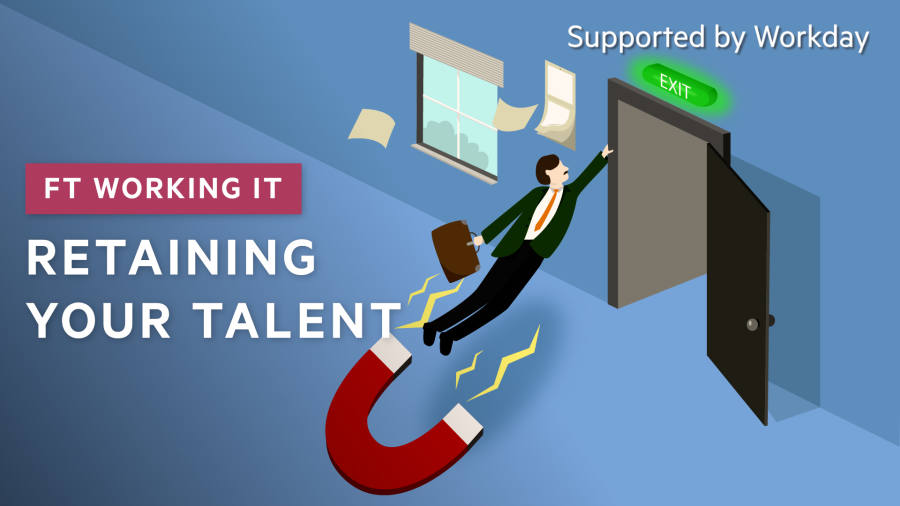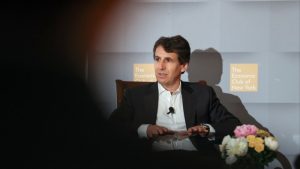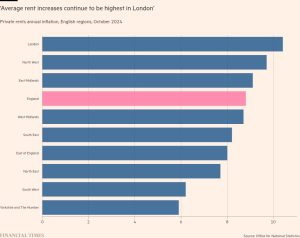How to retain your workforce

You can enable subtitles (captions) in the video player
For a long time labour was exchanged for financial reward. And employees were expected to feel grateful to have a job. But it’s no longer that simple. The meaning of work has changed. The global pandemic, retirement ages extending, and a new job-hopping generation have created a new reality for business leaders. And employers are having to think far harder about how to retain a happy and productive workforce.
I’m Isabel Berwick. I host the FT’s Working It podcast, and I write a newsletter about the workplace. In this series, I’ll explore some of the most pressing issues around the future of work and talk to senior leaders about how they are making work better…
…how is this going to evolve over time?
…for everyone.
Companies looking to future-proof their workforce are moving away from just thinking about the shareholders.
It’s not just about your customers or the general public, it very much is about your own employees. Lots of companies have found this, particularly, let’s say, big fossil fuel producers. So the issue that they found was that it wasn’t about the campaigners, it wasn’t about their investors, it was their own workforce that was criticising them. Because of technology, people and employees who are not happy will be quite vocal about it. They are calling out wrongdoing, however they see it.
Global PR firm Edelman produces research on trends in business and society. I invited the company’s global chair for workplace advisory, Cydney Roach, to the FT’s offices to talk about the trends she sees in employee engagement and what business leaders need to do next.
The meaning of work and its place in our lives has changed. Is that since the pandemic or does it go back further?
Social scientists have told us that when there are black swan events such as the pandemic, such as the recession in 2008-2009, that people re-examine their beliefs, whether it’s how they want to spend their time and what they want to prioritise. What we’ve seen is a shift in the employee expectations of the employer.
Of the four institutions that we at Edelman have been tracking – business, NGOs, media, and government – business is by far the most trusted. With this high trust comes exceedingly high expectations. Employers are now expected to fill the gaps from everything from healthcare, mental health, food deserts, physical well-being.
So if employers are fulfilling a much bigger role in their employees’ lives, a kind of everything organisation, the barrier between work and home has blurred. To me, that sounds like a kind of going back to the Victorian thing, like the Rowntrees and the Cadburys of really looking after their staff. Is that a correct way of looking at it?
I don’t see it that way, actually. I see… if you think about employee value proposition, technically, the definition is the give and the get between employee and employer. And I think it’s less paternalistic or familial than it’s contractual. These are my expectations of you as an employer. It’s not just a this is a nice to have anymore. This is part of the cost of doing business with me and my services as an employee.
It used to be more of a focus on from the employer point of view, here’s what I’m going to offer you in exchange for your work. And now it’s more of an equal contract.
Does that include things like excellent benefits and working conditions? Or is it more intangible than that?
Comp and ben – compensation and benefits – will always be the primary motivation. But we know from our own research and third-party research that there’s a rise of the belief driven employee. So employees will actually choose a place to work based on employers, where their values align. And I use that word values, but it could be beliefs, societal beliefs, political beliefs. People are really looking for the whole package.
A 2022 Edelman survey found that Gen Z respondents worried more than older peers about issues such as health and finances, were heavily involved in social and political causes, and believed companies should do more to solve societal problems.
Employers are finding it incredibly hard to understand how to deal with the younger generations in their workforce. Now, everyone’s always been worried about younger people in their workplace. That’s not necessarily new. But what’s different this time is that the youngest cohort are digital natives. How they think about their working day is very different from years past.
I worked late last night. Yeah, and I’m so tired and I’ve been in so many meetings today and everything…
This idea that you would slog away for this perk or this job opportunity in years to come, that calculation doesn’t quite exist in the same way. I think people want to see results far quicker. They also want to make sure that they are devoting their energies to the right thing at the right time.
The idea that you would just work 27 hours a day, or whatever it is, for a boss that you don’t particularly like or a company you don’t really believe in the values of, for example, these are calculations that are being made that just never used to exist before.
In 2023, Edelman found that 93 per cent of the workforce were influenced by co-workers in their 20s on topics work-life boundaries. LinkedIn, the social media platform, has been looking at volunteering and community connection as a key way to help engage and retain staff of all ages.
I do think this youngest generation is really motivated, wanting to feel like what they do matters, wanting to feel like they’re part of a community. I think what happened during Covid is there was no community or connection anywhere. And I think as we’re coming out of it there’s such a hunger to connect back and feel like you’re part of something bigger.
I went to LinkedIn’s headquarters in Silicon Valley to meet its VP of social impact, Meg Garlinghouse. Through Meg’s team, the company provides its staff with the chance to volunteer with the wider community.
So, Meg, tell me about this big space we’re in here.
This is one of three spaces we have in our office space around the world. It’s here, San Francisco, and in Dublin. Employees can actually reserve the space if they’re involved with a local organisation and they want to host something here. So it’s literally a space for the community.
And we also host a ton of trainings. We’re inviting jobseekers in who just want to learn more about how to create a LinkedIn profile, or they want some tips and tricks on video prep. So it really is our way to leverage what is part of our assets, which is our space, so that the community can take advantage.
Do you think the place of work in our lives has changed?
Employees’ expectations of what the workplace provides has changed so much. In addition to the employee feeling like they want their employer to help connect them and make them feel like what they do matters, I also think there’s this huge new trend of being the place where they’re in this constant state of upskilling, which is both good for the employee and good for the employer, and of course, good for the world.
Because as we all know, the shelf life of skills has never been shorter. So we collectively have to be in this mindset where we have to be upskilling. And I think that drives incredible engagement from employees as well.
We have a five-generation workforce now. What are the biggest challenges that all employers are going to face? And what are some of the ways we can engage people?
I love that there’s a five-generation workforce emerging, partly as I become on the older part of that generation. But there’s so much benefit. And I think one of the opportunities and one of the ways these volunteer engagement initiatives can help is creating and designing and being really intentional of how you bring people together. Because frankly, I can learn a whole bunch from a younger employee who I wouldn’t normally have an opportunity to intersect with.
By connecting with job seekers outside the organisation, LinkedIn staff are also improving their own skills, things like empathy, listening, and critical thinking.
I think we’ve seen in the data that people are moving jobs much more often than they used to, particularly younger people. We’ve talked a lot about upskilling. Do you think that that need is going to change the way that people relate to their employers? Are people going to stay longer, do you think? Is that possible in future?
It’s such an interesting insight. I do think we’re going to see that. And here’s why. I think as companies invest in employees to ensure they’re being upskilled, I think employees are going to actually appreciate that upskilling. And in doing so they’re going to be able to take advantage of internal mobility opportunities. So you don’t have to leave the company to grow your career.
You’ve seen tech companies laying off thousands of staff, and so now more and more younger people are thinking about portfolio careers, freelancing careers, where they might do two days of salaried work with one company, and then the rest of the time they are working on freelance projects. They’d rather take the hit. If you’re in the US, they’d rather pay for health insurance, or they’d rather pay for their own expenses and their own gym membership in order to be able to have more control over their whole financial existence.
Now, when times are really good, when work is readily available, this is an incredibly attractive way to live your life. I just wonder, when times get harder, when the economy is not doing as well, what happens then?
We all need to feel in control of our financial existence. But research shows that we expect a lot from our employers. It also shows that people want to have input into the strategy and culture of an organisation. The dreaded staff surveys asking for satisfaction levels don’t always help with that.
There’s a lot of inherent bias in surveys. And I highly recommend that clients supplement or complement engagement surveys with raw data. And you can ethically curate and scrape publicly available data on employees sites such as, of course, LinkedIn or Glassdoor. There’s a lot of forums that are publicly available where people share what’s going on in the organisation or how they’re responding to new regulations, regulatory environment. And especially in the tech sector there’s a lot of publicly available data, because tech people love. To chat with each other.
So when people chat with each other that’s where employers should be looking.
Yeah.
Collecting accurate sentiment data from employees is vital when mapping the temperature of a business. I’ve gone to Redmond, near Seattle, to meet with Microsoft’s VP of People Analytics, where data is at the forefront of their work.
So we’re walking essentially through a construction site here. Is it changing all the time here?
All the time, Yes. In fact, I’ve worked at Microsoft for over 25 years, and I have watched this campus change dramatically over 25 years.
I’m very fortunate that at Microsoft we really look at data over dogma to make these types of decisions. We have a robust employee listening system. And our employee listening system is made up of active and ambient listening. Active listening is when we push a survey to you. Ambient listening is when we listen to what’s going on around.
So an example of ambient listening is to understand collaboration data – calendar, email metadata, Teams metadata, to understand how people are working together so that we can say, you know what, maybe you don’t want to be in meetings 12 hours a day. You might need to build in some focus time so that you can get some work done and get some real good thinking time in.
So, yes, it really helps our managers so that they can understand how their teams are thriving, learn what’s on their employees’ mind, and have a conversation with them about what’s going well and where they can improve.
All of the staff’s listening data is stored in their Viva Glint platform, which uses AI to interpret the findings. So I know data is your thing, Dawn. What difference is AI making to how we can extrapolate the results of employee engagement surveys?
The biggest impact that AI is having, at least right now, is being able to discern the signal through the noise in the sentiment data that we have, especially for leaders that have large groups, to be able to, in a matter of seconds, understand the themes of the sentiment. That’s huge. Even a couple of years ago, people had to read through hundreds if not thousands of comments to really understand the actions that they can take.
Now, not only can it give you a summarisation of the insights, you can converse with your data – you can ask deeper questions. And that’s really what we are aiming to make easy for our managers and leaders.
It always used to be about pay. In your work internally and perhaps more generally in the field, where does pay sit now? Has the meaning and purpose of work become broader? It seems to me that it has.
I think it has. And while pay is absolutely important, there are other aspects of what employees are looking for from their employers. And the number one driver of thriving is career. Our employees want to make sure that they have the career experiences that are going to help them really be successful in their lives. And that’s the number one reason why people leave Microsoft. It’s not for financial reasons, it’s for career experiences.
We like to say, there’s no one size fits all. And that’s why it’s so important that managers really do sit down with their employees, talk about career, talk with their teams about thriving, really understand what drives their teams and their employees.
So much of our working life creates a data trail. And more and more companies seem to be harnessing this to increase staff productivity. But Microsoft has shown that it also has the ability to help retain staff.
We’re looking now to get richer insights into our people. In the same way that you would map that for a consumer and a consumer product, we can do that for the workforce because that’s when you’re going to know exactly which levers and drivers are motivating people, or frustrating them, or challenging them in good ways.
Investing in finding out what your staff want or don’t want and then delivering those positive benefits is expensive and time-consuming. At the moment, very few companies are really doing it properly. But there’s also a huge cost when leaders are not taking good care of their staff. That impact of lack of trust and of economic pessimism might even have political implications.
The businesses that will do well are the ones that are thinking about their workforce in terms of skills. Those companies that say to their employees, look, we are going to help you build your skills while you are here. We will help train you. We will help develop you. And we’d love for you to join us on our journey as we grow as companies for however long that may be. And if you think about it in that open-ended way, there’s probably more of a chance that people will stick with you.
After filming this, I became convinced by one thing: the future of work will belong to the leaders who treat their staff with the same care and respect that they give to customers.
#retain #workforce







